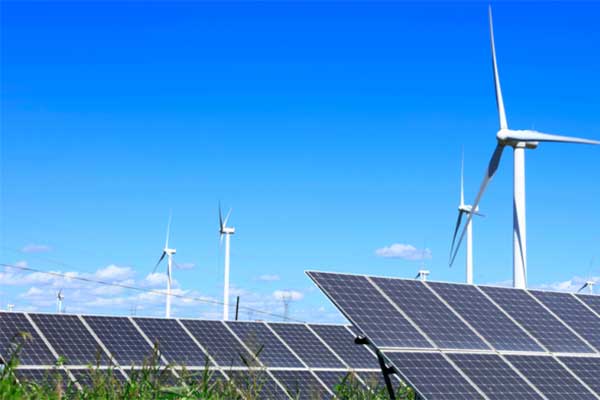According to a review by the SUN DAY Campaign of data recently released by the Federal Energy Regulatory Commission (FERC), renewable sources accounted for almost 70% of the new U.S. electrical generating capacity added during the first eight months of 2022. Moreover, net new “high probability” additions by solar and wind over the next three years are now projected to be more than 26-times that of natural gas.
Renewables Provide Almost 70% of New Capacity in First Two-Thirds 2022:
Wind (7,514 MW) and solar (5,711) provided 68.79% of the 19,224 megawatts (MW) in utility-scale (i.e. > 1-MW) capacity put into service during the first two-thirds of the year. Additional capacity was provided by geothermal (68-MW), biomass (18-MW), and hydropower (10-MW). Combined, renewable sources accounted for 69.29% of the total. The balance came from natural gas (5,878-MW), nuclear (17-MW), and oil (8-MW). No new capacity was reported for 2022 from coal.
New capacity reported in August alone comprised 13-MW of geothermal steam and 238-MW of solar. The latter includes the 104.0-MW Graphite Solar Project in Carbon County, UT, the 66.5-MW Quinebaug Canterbury Solar Project in Windham County, CT, and the 50.0-MW Bear Creek Solar Project in Richland, WI, among others.
These recent additions bring renewable energy’s share of total U.S. available installed generating capacity up to 26.86%: wind – 11.24%, hydropower – 8.02%, solar – 6.06%, biomass – 1.22%, and geothermal – 0.32%. For comparison, five years earlier, renewables’ share was 19.78%. Ten years ago, it was 14.74%.
FERC Foresees Very Strong Solar and Wind Growth in the Near Term:
Perhaps more dramatic are the trend lines indicated by FERC data for the next three years – i.e., through August 2025.
FERC reports that there may be as much as 195,086 MW of new solar capacity in the pipeline with 67,147 MW classified as “high probability” additions and no offsetting “retirements.” The “high probability” additions alone would nearly double utility-scale solar’s current installed capacity of 76,040-MW, while successful completion of all projects in the pipeline would nearly quadruple it.
In addition, new wind capacity by August 2025 could total 69,954 MW with 17,595 MW being “high probability” and only 146-MW of retirements expected. Thus, installed wind capacity (now 141,100-MW) could grow by at least 12.5% and possibly by much more.
“High probability” generation capacity additions for utility-scale solar and wind combined, minus anticipated retirements, reflect a projected net increase of 84,596-MW over the next three years, or over 2,350 MW per month. That figure does not include new distributed, small-scale solar capacity or additions by hydropower, geothermal, and biomass.
Prospects for Natural Gas Plummet:
Possibly more startling is how little net new natural gas capacity FERC anticipates being added over the next three years – just 3,200-MW (i.e., 20,880-MW in “high probability” additions minus 17,680-MW in retirements). That is significantly less net new gas capacity by August 2025 than the new gas capacity that was added in the first two-thirds of 2022. For perspective, in August 2019, FERC had foreseen 19,757 MW of net new natural gas additions in the three-year pipeline. The newly-reported sharp drop in natural gas pipeline projects suggests a major reversal for its prospects.
FERC also expects new nuclear additions to total 2,200 MW (i.e., the two new reactors being constructed at the Vogtle nuclear plant site near Waynesboro, Georgia).
If just FERC’s latest “high probability” projections materialize, by August 2025, renewable energy sources would grow from over a quarter today to nearly a third (31.88%) of the nation’s total installed generating capacity. Utility-scale solar and wind generating capacity would expand from 17.30% of domestic capacity today to 22.78% by August 2025 with solar and wind accounting for 10.81% and 11.97%, respectively.
Meanwhile, natural gas’ share would contract from 44.25% today to 42.20% by August 2025. If current trends continue or – as seems likely – accelerate, renewable energy generating capacity should overtake that of natural gas by 2030, if not sooner. Moreover, coal’s share of the nation’s generating capacity would fall from 17.54% to 15.12% by August 2025 while that of nuclear power would decline from 8.16% to 7.90%.
In Conclusion…
“FERC’s latest data do not yet reflect the impact of the recently-enacted Inflation Reduction Act,” noted the SUN DAY Campaign’s executive director Ken Bossong. “It is therefore not unreasonable to expect the already strong growth of renewable energy to accelerate rapidly in the near term and continue to displace fossil fuels and nuclear power.”
Notes:
[1] Capacity is not the same as actual generation. Capacity factors for nuclear power and fossil fuels tend to be higher than those for most renewables. Thus, in its most recent “Electric Power Monthly” report, the U.S. Energy Information Administration (EIA) reported that renewables accounted for 24.2% of the nation’s total electrical generation in the first seven months of 2022 – that is, somewhat less than what FERC reported was their share (26.86%) of installed generating capacity for the same period.
[2] FERC generally only reports data for utility-scale facilities (i.e., those rated 1-MW or greater) and therefore its data do not reflect the capacity of distributed renewables, notably rooftop solar PV which – according to the EIA – accounts for almost 30% of the nation’s electrical generation by solar. That would suggest that the total of distributed and utility-scale solar capacity combined is significantly more than the solar capacity of 6.06% reported by FERC for the first two-thirds of 2022 and is perhaps closer to 8.5%.
—
This article was written by The SUN DAY Campaign. Its a non-profit research and educational organization founded in 1992 to support a rapid transition to 100% reliance on sustainable energy technologies as a cost-effective alternative to nuclear power and fossil fuels and as a solution to climate change.















Comments